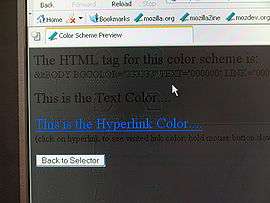Image persistence
Image persistence, or image retention, is the LCD and plasma display equivalent of screen burn. Unlike screen burn, the effects are usually temporary and often not visible without close inspection. Plasma displays experiencing severe image persistence can result in screen burn-in instead.


Image persistence can occur as easily as having something remain unchanged on the screen in the same location for a duration of even 10 minutes, such as a web page or document. Minor cases of image persistence are generally only visible when looking at darker areas on the screen, and usually invisible to the eye during ordinary computer use.
Cause
Liquid crystals have a natural relaxed state. When a voltage is applied they rearrange themselves to block certain light waves. If left with the same voltage for an extended period of time (e.g. displaying a pointer or the Taskbar in one place, or showing a static picture for extended periods of time), the liquid crystals can develop a tendency to stay in one position. This ever so slight tendency to stay arranged in one position can throw the requested color off by a slight degree, which causes the image to look like the traditional "burn-in" on phosphor based displays. In fact, the root cause of LCD image persistence is the same as phosphor burn-in, namely, non-uniform usage of the display's pixels.
The cause of this tendency is unclear. It might be due to accumulation of ionic impurities inside the LCD, electric charge building up near the electrodes,[1][2] parasitic capacitance,[3] or "a DC voltage component that occurs unavoidably in some display pixels owing to anisotropy in the dielectric constant of the liquid crystal".[4]
Prevention/Treatment
According to an instruction manual of an LCD monitor by NEC Display Solutions,[5]
Image persistence is when a residual or “ghost” image of a previous image remains visible on the screen. Unlike CRT monitors, LCD monitors’ image persistence is not permanent, but constant images being displayed for a long period of time should be avoided.
To alleviate image persistence, turn off the monitor for as long as the previous image was displayed. For example, if an image was on the monitor for one hour and a residual image remains, the monitor should be turned off for one hour to erase the image.
NOTE: As with all personal display devices, NEC DISPLAY SOLUTIONS recommends using a moving screen saver at regular intervals whenever the screen is idle or turning off the monitor when not in use.
Image persistence can be reversed by allowing the liquid crystals to return to their relaxed state. In other words, turning off the monitor for a sufficiently long period of time (a few hours or maybe days) will relax the crystals and eliminate image retention. For most minor cases, simply continuing to use the computer as usual (and thus allowing other colours to "cover" the affected regions) or turning off the monitor for the night is more than enough.
Ideally, you want to vary your computer activities to avoid static colours and hide elements on the screen which are displayed perpetually (such as an OS's Taskbar). The usage of a screensaver can help during times the computer is left unattended.
One proactive approach to removing image persistence is to cover the entire display area with pure white for an extended period of time.[6] An easy way to do this is to navigate to "about:blank" in any web browser and press F11 to cover the entire screen.
References
- Image persistence: LCD monitors Archived 2008-12-27 at the Wayback Machine. Mitsubishi Electric, January 2006 (?)
- WHITEPAPER LCD technology and image retention Archived 2016-05-23 at the Portuguese Web Archive. Koninklijke Philips Electronics N.V. ©2009
- Pixels and Image Sticking. Tyco Electronics technical support (pre-2008)
- K. Kusafuka, H. Shimizu and S. Kimura, Driving method for gate-delay compensation of TFT/LCD. IBM Journal of Research and Development, Volume 42, Numbers 3/4, 1998
- https://www.necdisplay.com/documents/UserManuals/EA275UHD_CD_EN_UserManual.pdf
- "Avoiding image persistence on Apple LCD displays". Apple. Retrieved 18 Oct 2013.